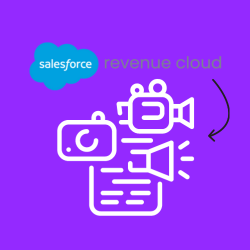BLOG
Revenue Cloud Solutions Headline in the Media Industry

With the onset of an AI-backed, data-driven, cloud-based digital system, the curtains have opened to reel in a new audience and deliver an unprecedented entertainment experience wherever and whenever customers want it.
But managing such an elaborate scheme of multitiered subscriptions, self-service portals, billing, and data analysis for a personalized customer experience is constantly filled with surprise plot twists. Companies like yours are seeking new ways to avoid cliffhangers and ensure a happy ending.
According to Gartner research, 91 percent of businesses are investing in some form of digital initiatives, and 87 percent of senior business leaders say digitalization is a priority for their operations. With all this buzz about AI and cloud-based systems, how can these innovations benefit your company?
Automated functionality? Great.
Uses a centralized CRM? Amazeballs.
But when it comes to improving revenue streams, business leaders want functionality that
- expands revenue opportunities,
- improves efficiency for more revenue streaming opportunities,
- simplifies and personalizes customers’ purchasing experience for even more revenue growth, and
- provides ways to track those earnings accurately.
Many leading media companies turn to Salesforce Revenue Cloud because of its AI-backed, real-time, data-driven features that consolidate and automate CRM processes and manage revenue stream oversight from a centralized source. Some liken its success to finding loose change in the couch cushions.
But let’s start at the beginning: your data.
Data Quality
A CRM is only as good as the data available to analyze. Data quality isn’t defined by quantity; sheer volume doesn’t forge great data. Instead, it’s measured by accuracy, consistency, relevance, and completeness. Also, teams must consider if the data aligns with the company’s objectives.
Studies show that bad data quality can result in an average of $15 million in losses per year. The common culprit for piling up stacks of spurious data is a need for more data strategy, and that will impact your bottom line.
“Not only can poor data quality reduce efficiency and lower revenue, but it can also drive up your expenses,” says Daniela Cajigal, a content marketing expert. “Even more surprising is that despite these staggering numbers, only a measly 3% of companies have a formal data quality strategy in place. This means that the vast majority of businesses are not taking a proactive approach to addressing this issue.”
To optimize your digital transformation, we recommend working with an expert team to engineer a Salesforce instance that leverages valuable data and delivers a comprehensive perspective on the entire customer journey, encompassing the stages of customer acquisition and retention while also delivering robust capabilities for controlling subscription strategies, pricing structures, invoicing procedures, payment handling, and additional functionalities.
If your stakeholders are waiting for you to “show them the money,” let’s break down how Salesforce Revenue Cloud can make it rain.
Expand Revenue Opportunities
When all things are considered equal, it’s a simple fact that the first sales team to present a competitive price quote will likely get the sale. It’s not rocket science. But if your sales team uses manual processes to stay updated on complex subscriptions, multi-tiered services, and contracts, it may feel like it.
Using automated AI-enhanced tools that handle price quotes, billing, contract management, and sales analytics tools on CPQ within Revenue Cloud, sales teams can expedite critical stages in the sales cycle of the contract creation process, ensuring that deals are closed faster and revenue is recognized sooner.
Notable Features
Revenue Analytics: Revenue Cloud offers robust analytics and reporting tools to gain insights into customer behavior, revenue trends, and content performance, which can inform business strategies.
System Integrations: Revenue Cloud can integrate with other systems and tools—such as marketing automation, content management, and analytics—to create a seamless end-to-end revenue management ecosystem.
Customized Scalability: Revenue Cloud is designed to scale and seamlessly accommodate increased data volumes and complex revenue models. The platform offers APIs and customization options, allowing companies to tailor the system to their business needs and workflows.
Automation and Guided Selling: CPQ tools can guide reps through the sales process, making it easier to identify and propose relevant products, bundles, and services to customers. This guidance can result in more effective sales strategies and higher revenue.
“When you employ a QTC solution, your salespeople are free to engage the customer with a quote confidently and in an instant,” says Danny Wong at Salesforce. “Detailed pricing information is updated in real time throughout your systems, so you can always be confident that your customers will receive accurate information.”
Wong points out that over half (65 percent) of all sales quotes end without a purchase. With Revenue Cloud and CPQ managing sales cycles, your sales team can beat those odds and welcome new revenue-streaming opportunities.
Improve Efficiency for More Revenue Streaming Opportunities
The standout aspect of the Revenue Cloud is its remarkable automation capability, alleviating the burdens of manual approval processes, data validation, and transferring orders between systems. Equipped with CPQ capabilities, Salesforce Revenue Cloud streamlines sales orders and generates invoices automatically, facilitating the sales cycle and addressing concerns like underbilling for services and revenue loss.
Additionally, the intuitive dashboard provides a comprehensive view of clients’ purchases, enabling you to monitor transaction progress over time and promote collaboration among diverse teams to optimize cost-saving investments.
Notable Features
Billing and Invoicing: Revenue Cloud streamlines the billing and invoicing process, ensuring accurate and timely revenue recognition and helping reduce revenue leakage, particularly with contracts and subscriptions.
Subscription Management: Media companies can manage various subscription models, from monthly subscriptions to tiered plans and usage-based pricing, all within a single platform.
Cross-Selling and Upselling: Quickly identify AI-supported, real-time, data-driven opportunities for cross-selling and upselling to maximize revenue from existing customers.
Revenue Cloud ensures that sales, pricing, quoting, and revenue management processes are tightly connected and provide a unified Customer 360 view of customer data and sales activities. This integration ensures consistency in data and helps sales teams better understand the ever-changing customer needs and preferences.
Personalize the Purchasing Experience
Recent polls found that 97 percent of consumers and 98 percent of contact center managers say customer service interactions impact whether consumers stay loyal to a brand. Finding out what customers want from your brand is a strategic process.
Personalization is where data quality and clear business objectives take center stage. With segmentation capabilities, for instance, your sales and marketing teams can connect with new and existing customers using generative AI tools to present services your customers want, packaged in the most desired forms.
Research shows that it costs companies five times as much to gain a new customer as it does to keep existing ones. With customer-focused data analytics, sales teams can track changes in buyer behaviors and extend personalized offerings to reduce the risk of customer churn while presenting maximum customer satisfaction.
Notable Features
Customer-Focused Data Analytics and Insights: Generate real-time data-based insights to identify trends, opportunities, and areas for improvement. This data-driven approach can lead to more effective sales strategies and revenue expansion. For instance, do your customers want self-service portals or mobile application access? Yeah, we can do that.
Segmentation and Targeting: Leverage rich data to segment your customer base by demographics, purchase history, or engagement levels. Sales teams can then create targeted sales and marketing strategies for each segment, ensuring that their messaging is highly personalized and relevant.
Pricing Optimization: By considering customer-specific factors such as buying history and preferences, businesses can offer personalized pricing, discounts, and promotions to specific customers, increasing the likelihood of closing deals.
Optimized Product Configurations: CPQ systems enable businesses to offer customized product configurations that meet specific customer needs. This personalization can lead to upselling and cross-selling opportunities, as customers are more likely to purchase products that align with their unique requirements.
Implement Intelligent Tracking Technology
Revenue growth is good. Reporting profits is even better. But knowing exactly where your revenue streams stand via real-time data analysis is a blockbuster. Revenue Cloud doesn’t pull data just because it can; intelligent, data-driven insight about your company’s earnings goals is a crucial strategy for future growth.
Notable Features
Advertising Revenue Management: CPQ assists in managing advertising revenue by providing ad placement, tracking, and reporting capabilities. This helps optimize ad campaigns and increase ad sales.
Revenue Forecasting: Revenue Cloud provides tools for forecasting revenue based on existing data, which can help businesses make strategic decisions to expand revenue opportunities.
Automated Workflows: Use Revenue Cloud to automate revenue-related workflows, such as revenue recognition, billing, and collections, based on predefined rules and triggers. This reduces manual intervention and improves tracking accuracy.
Compliance and Audit Trails: Maintain a clear audit trail of revenue transactions, making it easier to demonstrate compliance with financial regulations and providing transparency for internal and external audits.
Mobile Access: Sales and finance teams can access revenue tracking data through mobile devices, enabling them to stay updated and make informed decisions while on the go. Around 89 percent of all companies have already adopted a digital-first business strategy or are planning to do so—including your competitors.
Revenue Cloud is an indispensable tool for media companies in the digital era. It helps diversify revenue streams and enables a deeper understanding of the audience, streamlines operations, and supports adaptation to the ever-changing media landscape.
Revenue Cloud provides a robust and adaptable solution to secure and enhance revenue as the media industry continues to evolve, making it a “two-thumbs up” choice for media companies looking to succeed in the digital age. To learn more about ways Salesforce Revenue Cloud can power up your revenue opportunities, contact us today.
Want to know what Revenue Cloud can do for your business? Contact us today!
Ready to Start Loving Salesforce?
Contact us today to learn how we can help make Salesforce your business’s unfair advantage.
Quick links
Quick contact
-
Thunder
548 Market Street PBM 88159
San Francisco, CA 94104 - Contact Us
All rights reserved © 2025

